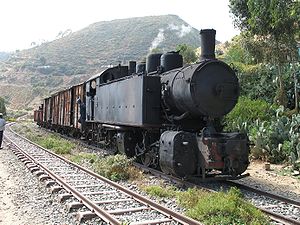- Mogadishu-Villabruzzi Railway
-
The Mogadiscio-Villabruzzi Railway (Italian: Ferrovia Mogadiscio-Villabruzzi) was the railway of Italian Somaliland, and connected the capital of Somalia with the Shebelle river agricultural areas from 1914 to 1941.
Contents
History
It was built initially for the surrounding area of Mogadishu (Mogadiscio in Italian) after World War I. In the 1920s, H.R.H. Principe Luigi Amedeo, Duca degli Abruzzi, a senior member of the Italian Royal Family, had the railway extended to the Shebelle River colonial villages he was then developing. [1]
The line, 114 km long, reached Villabruzzi (then in full "Villaggio Duca degli Abruzzi", now "Jowhar") in 1928. The original proposal was for the railway to go on from Villabruzzi to the Somali border with Ethiopia and into the Ogaden, but the Second Italo-Abyssinian War in 1936 stopped further construction.
In 1939 the Italian leader Benito Mussolini planned road and rail connections between Mogadiscio and Addis Ababa, but only the road ("La Strada Imperiale") was built before World War II destroyed the Italian Empire. However, a small "decauville" railway of 200 km was built between Villabruzzi and the border with Ethiopia in order to solve the logistical problems related to the occupation of Ethiopia.
In 1941 the railway was dismantled by the British troops when they conquered the "Africa Orientale Italiana". Since then the railway, except for a few tracks within Mogadishu harbour, was no longer used. In 1942 some diesel locomotives and related materials were moved by the British Government to Eritrea, to be used on the Massawa-Asmara railway.
In the 1980s, the Somalian president Siad Barre proposed the reactivation of the railway, but his fall in 1991 stopped the possible reconstruction.
Statistics
The railway in 1930 moved 19.359 passengers, and was used by even for tourism. In the same year 43.467 tons of products (mainly agricultural) were transported, with earnings up to 1.591.527 Lira somala. Most products transported were bananas and coffee, from farm plantations of the area of Villabruzzi, to be exported through the port of Mogadishu.
It was administered by the Ferrovie Somale, a government company.
The single track railway had a 950 mm (3 ft 1 3⁄8 in) narrow gauge, as established in 1879 by an Italian law on minor gauges.
Equipment
The equipment of the Somalian railway was similar to the one used in the Eritrean Railway.
Steam locomotives
Three classes of steam locomotive were used: one design of 0-4-0 shunter and two designs of 0-4-4-0 Mallet for line service.
202 Series
These small 0-4-0 tank engines were and are the standard shunter locomotives of the system, built between 1927 and 1937 by the firm of Breda in Milan. They have short side tanks, a rear coal bunker, and a unified, oval dome containing the steam dome inside a larger sand dome - this arrangement, popular worldwide in nations that favored the sand dome, helped both to insulate the steam dome and to keep the sand dry with the warmth. Large, prominent builder's plates adorn the domes. They use Walschaerts valve gear with piston valves and superheating.
440 Series
One of these early Mallet locomotives, which is a true Mallet and thus a compound, still exists in storage at the Asmara railway Station. It was a 1915 product of Ansaldo in Genova.
442 Series
These later, and much larger, compound Mallet locomotives were built by Ansaldo in Genova in 1938 to largely replace the earlier types, both the 440 Series and the unsuccessful 441 Series, which were simple locomotives (i.e., non-compound) and found liable to run out of steam on the heavy grades of the line. Like the other locomotives they are tank engines with large side tanks and a rear coal bunker, under cover of the cab roof in this design. These are quite hefty machines, as required by the tough demands of the terrain.
Railway stations
Name Distance Altitude Mogadiscio 0 km (0.0 mi) 0 m (0 ft) Ponte sullo Shebelle 30 km (18.6 mi) 18 m (59 ft) Afgoi 50 km (31.1 mi) 64 ft (20 m) Adalei 66 km (41.0 mi) 78 m (256 ft) Garsala 80 km (49.7 mi) 88 m (289 ft) Moico 90 km (55.9 mi) 91 m (299 ft) Ponte sullo Shebelle 111 km (69.0 mi) 96 m (315 ft) Villaggio Duca degli Abruzzi (Jowhar) 114 km (70.8 mi) 108 m (354 ft) See also
- Eritrean Railway
- Italian Somalians
- Italian Somaliland
- Rail transport in Somalia
- Transport in Somalia
Notes
Bibliography
- Antonicelli, Franco. Trent'anni di storia italiana 1915 - 1945. Mondadori Editore. Torino, 1961.
- Del Boca, Angelo. Una sconfitta dell’intelligenza. Italia e Somalia. Laterza Editore. Bari, 1993.
- Tripodi, Paolo. The Colonial Legacy in Somalia. St. Martin's P Inc. New York, 1999.
External links
Categories:- Rail transport in Somalia
- Rail transport in Africa
- Italian East Africa
- Mogadishu
- History of Somalia
Wikimedia Foundation. 2010.




